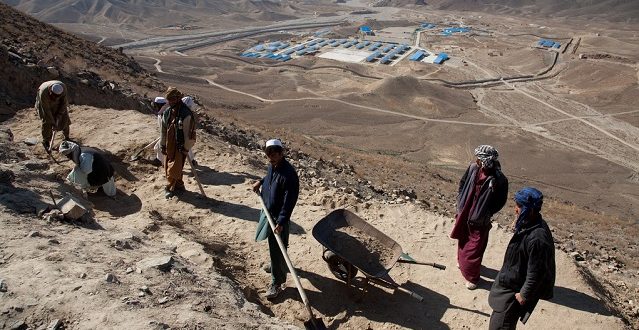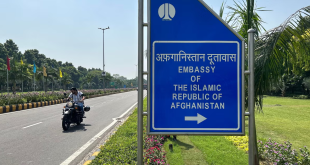By Andalib Asem
Afghanistan is endowed with immense mineral and hydrocarbon resources, including gold, lithium, copper, lead, precious and semi-precious stones, natural gas, petroleum, and many others. In 2010, US geologists conducted an aerial survey that discovered untapped mineral deposits worth more than $1 trillion. While Afghanistan faces a plethora of investment challenges, these minerals resources, if governed by conducive investment policies and an adequate degree of administrative capacity, have the potential to make significant contributions to generate revenue, develop infrastructure, create employment, and finally turn into robust pillars of economic growth.
For now, Afghanistan is faced with numerous challenges on almost all fronts. Insurgency-related violence is mounting, foreign aid is dwindling parallel with foreign troops’ departure, and the economy is shrinking – due to capital outflow, brain drain, and insecurity. These challenges and risks are of great concern, and if not dealt with, they may plunge the country into chaos. Given these risks and vulnerabilities, how can Afghanistan counter the challenges mentioned above? Apparently, Afghanistan can gradually exploit its hugely significant minerals to provide its people with employment and economic opportunities and prevent them from falling prey to insurgent and terrorist groups. Although it will take an incredible amount of time for Afghanistan to fully exploit and operationalize its mining industry, several medium and large mineral projects’ contracts have already been awarded. However, these projects are suspended due to some challenges. It needs capacity and political will on the part of the Government of Afghanistan to harness resources, increase administrative capacity, and reform its investment relevant policies to tackle the impediments and reap the acutely needed fiscal revenues. These revenues generated from mining could fill the funding gaps created by diminishing foreign aid.
Among other unexploited mineral deposits in the country, the Aynak Copper Mine, located around 40 kilometers south of the capital, Kabul, is one of the world’s largest untapped copper resources. Estimates of the Ministry of Mines and Petroleum of Afghanistan show that the mine contains more than five million tons of copper worth more than $50 billion. According to some accounts, the Aynak Copper Mine was first discovered by the former Soviet geologists in the 1960s. However, the geologists prospected the mine from 1974 to 1978 and conducted tentative development from 1979 to 1988. The mine’s development was suspended after the former Soviet Union withdrew from Afghanistan in 1989. Following a protracted and competitive bidding process, supported by international technical assistance, the Government of Afghanistan awarded the contract to the Chinese state-owned Metallurgical Corporation of China (MCC) and Jiangxi Copper Corporation in 2008. The consortium later created MCC-JCL Aynak Minerals (MJAM) to formally operate the project. Nonetheless, the project did not advance as expected due to technical and legal challenges, including security, the discovery of artifacts on the site, and lack of progress in the mining contract’s renegotiation. The Aynak Copper Mine Project’s significance is tremendous, and if developed, the project can create thousands of jobs, boost and diversify the economy, and contribute to the country’s stability. Likewise, it will strengthen the Sino-Afghan economic ties, develop the Afghan mining industry, and attract further foreign investments in the extractive sector. Moreover, the wealth of Aynak has the potential to help improve security, which has emanated from poverty, widespread unemployment, and lack of economic opportunities.
Estimates indicate that the Aynak could create around 7,000 direct and 13,000 indirect employment opportunities in the mine’s construction and operation phase. Given the current precarious economic conditions, the number of jobs generated both directly and indirectly is as significant as the financial income that the project will generate. In tandem with these, the project will also generate employment opportunities through ancillary projects, subcontracting, and multiplier effects. Similarly, another benefit of this large project is the foreign exchange it can bring into the country; nevertheless, the impact may not be significant given Afghanistan’s weak industrial base. A large amount of foreign exchange will go towards importing capital equipment and raw materials.
In the meantime, as part of the financial obligation specified in the Mining Contract, the company will pay the Government of Afghanistan a substantial amount for the mine’s rights as “Premium”. Similarly, based on Afghanistan’s Income Tax Law provisions, taxes will be applied to all taxable incomes. More importantly, once the commercial production is underway, the company will pay royalties on minerals mined and processed from the Aynak deposit in accordance with the details of the renegotiated Mining Contract.
Mining has the potential to transform a nation from underdevelopment to socioeconomic development and prosperity. Afghanistan’s abundant minerals remain untapped amid the growing global demand for minerals like copper and iron ore, which are projected to continue their essential role in the world economy. While Afghanistan has a limited presence in the global economy, the increase of revenue associated with minerals extraction will contribute to national stability and the improvement of schools, roads, and other public infrastructures.
Although the Aynak Copper Mine Project alone may not bring about financial independence, security and realize the aspiration to attract adequate foreign direct investments, establish a comprehensive Sino-Afghan relationship, its success will be a gateway to future Chinese investment in extractive and other key sectors. Materializing this project can be considered the beginning of concrete and pragmatic steps towards building stronger economic cooperation and further investment from the friendly neighbor, the People’s Republic of China.
At present, there are 12 Chinese companies involved in Afghanistan, including Petro China, China Railway, China Metallurgical Group, ZTE Corporation, and Huawei Technologies. However, the successful development of Aynak will attract more foreign investments from China and other regional countries.
The Way Forward
To tackle the technical and legal issues that have stopped the project’s progress, both parties need to enter a sincere and result-driven renegotiation of the contract. Both sides, particularly the Government of Afghanistan, should overcome the existing reluctance and launch renegotiation of the Mining Contract’s terms based on the same contract, which is publicly available on the Ministry of Mines and Petroleum’s website.
In addition to renegotiating the contract’s terms to make the investment mutually beneficial, the Government should accelerate the excavation and preservation of the cultural artifacts while also reviewing the project’s security measures to address any potential vulnerabilities and give the best of assurance to the investor. In the meantime, the Government needs to strengthen administrative, technical, and management capacity within the relevant governmental institutions to manage the investment and address the current inadequacies properly. Simultaneously, the author has learned that Afghanistan’s president has already endorsed the open-pit mining method for the project as the company’s studies have confirmed it technically and economically feasible. Therefore, both sides should move forward and avoid lingering on it.
Meanwhile, risk management practitioners believe that the company’s approach towards the investment in Aynak is ‘risk-averse’ rather than ‘risk-tolerant’ as far as the project’s physical security is considered. As such, it is time for the investor to reconsider its risk perception and become rather ‘risk-tolerant’ because Afghanistan is conflict-ridden and is currently in the middle of a war. Hence, it will be unrealistic to await and expect maximum security in the foreseeable future. Similarly, the investor should quickly begin the project’s investment and operation as soon as both parties break the current impasse by removing the pending issues.
 Afghanistan Times
Afghanistan Times




